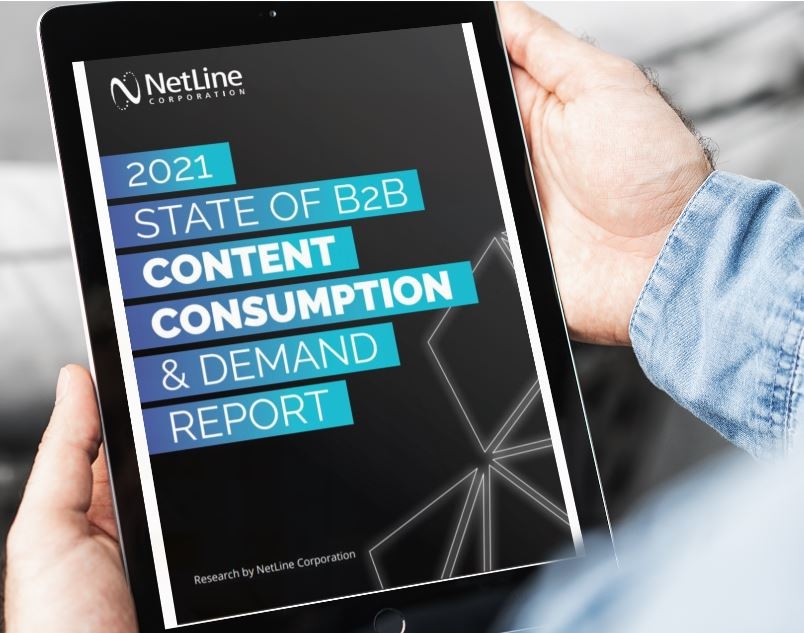With the pandemic shaking up B2B in 2020 and marketers ramping up their content production to meet the demand for information, the amount of educational content produced and consumed going into 2021 increased significantly. The 2021 State Of Content Consumption & Demand Report from NetLine revealed that 83% of the content consumed between February 1st and September 30, 2020 equaled the total percent of content consumed throughout all of 2019, highlighting how much B2B organizations craved information to inform their pandemic strategies.
“Covid-19 drove people to consume content at a much higher clip,” said Jonathan Steiert, Content Marketing Manager at NetLine, in an interview with Demand Gen Report. “There were a lot of questions that people had during this time. People needed information, whether it was work-from-home stuff, how HR impacts teams, all of that. It’s crazy to think that almost two-thirds of an entire year got that close to a full 12 months’ consumption rate.”
Content consumption increased going into 2021 by an additional 22%, with industries such as IT, collaboration software and human resources (HR) consuming the most. Steiert pointed out that most of these industries were consuming specific content types with relevant information about organizational operations. Sixty three percent of that content was E-books, strategy guides and white papers, and included information on topics such as how to effectively work from home, how to encourage internal collaboration and best practices for identifying important data to leverage.
The report also showed that the time between download and consumption decreased by 15%, leading marketers to believe that producing more content was the best strategy. As a result, there was a 150% increase in the total amount of content produced going into 2021.
With the increase in content volume and decrease of download to consumption time, Steiert believes many marketers were looking for new ways to create engaging content that met the demand. As a result, marketers addressed the consumption gap by creating content that was hyper-focused on buyers’ needs, pain points and preferences.
Turning To Targeted Content To Improve Virtual Engagement
One of the biggest takeaways from the report was the push for more humanized content, with many B2B organizations seeking highly targeted content that addressed their pain points during and after the pandemic.
The research showed that IT accounted for 39% of all content downloaded throughout the pandemic, while 17% was consumed by HR and operations teams. The research also cited that the work-from-home mandates played a pivotal role in the increase in content consumption, as many industries focused on finding successful strategies that encouraged employee communication and satisfaction.
“Those folks were directly responsible for evolving their company,” said Steiert. “Within about a week, most organizations went from in-person, in a physical location, to catering fully to an entirely remote workforce. They had questions, and actively sought out content that provided them with the answers they needed.”
The report also highlighted the impact of white papers and E-books, as they were the two most consumed content formats for learning about specific pain points. These formats also saw the most engagement. Additionally, there was a 103% increase in webinar content, which targeted remote workforce buyers that were looking for meaningful advice and best practices to inform their strategies.
David Fortino, Chief Strategy Officer at NetLine, believes these targeted content types provided organizations with the best practices they need to connect with their buyers, and that smart marketers will create similar content that reflects the consumers’ cravings in 2021.
“Events and content will become more bespoke,” said Fortino. “It’ll be designed for more curated audiences, more selective attendees related to their sponsors, more executive networking. Content consumption is now really focused in that way, and organizations are building content to reflect that.”
Managers Leveraging Content To Improve Operations
Another major trend in content consumption was the increase in consumption at the highest levels of an organization. According to the research, 68% of all content consumption was happening at the manager level and above, highlighting targeted content as a priority for executives. Fourteen percent of content was consumed by C-level employees, who were consuming that content 15% faster than all other organizational roles.
With many organizations placing emphasis on internal alignment and collaboration while working remotely, relevant content was — and still is — essential to building up workflows and marketing strategies.
“In business, the cost of doing nothing is always going to be a worse outcome than doing something,” said Fortino. “In the B2B world, marketers choose to educate themselves. Whether it’s their career path, their own way of managing their team, to technology, it’s good to see that executives made the choice considerably across their industries, to say, ‘Look, we’ve got to do something.’”
The report also highlighted how executives at smaller businesses accounted for more than 65% of content downloads, citing challenges with revenue and internal communication as the reasons for seeking out targeted content. SMBs were looking to their larger B2B counterparts for inspiration, consuming their content about revenue strategies and marketing alignment to inform their own processes.
“Smaller executives were struggling just as much as the big businesses, as the challenges were the same,” Steiert explained. “This is unchartered territory for all of us. But executives took it upon themselves to try to lead by example and educate themselves through other people who may be in a better position to comment on these things.”
For additional insights on the state of B2B content consumption, check out the full report.







